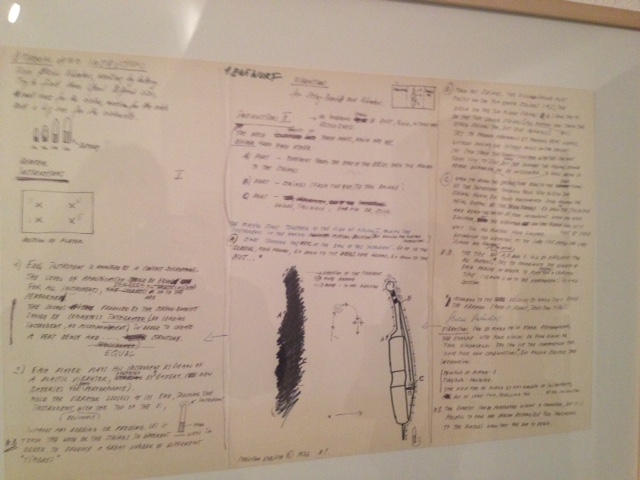 |
| Conceptual sketch for a composition by Christina Kubisch, Rumpsti Punpsti Berlin |
Early this week I wrote a pitch for Frieze Germany. Idea was to write a piece about Christina Kubisch, who’s exhibiting her awesome 1970s compositions with vibrator and flute at Rumpsti Pumpsti in Berlin. It would be part review, part discussion on feminism and new music in the 1970s (think the great Charlotte Moorman), and part reportage of 1970s sex industry (it was not easy back then for a woman to buy vibrators). I got the answer that the topic is “not quite right for Frieze.” Of course that made me wonder which part of the topic is not quite right for Frieze - feminism, 1970s compositions with vibrators, or Rumpsti Pumpsti? I wrote back and suggested an exhibition opening at a big museum, one that is curated by a famous male curator - I’m waiting for a reply and hope this might fit Frieze better. This week The Wire published an interview with sound artist Christine Sun Kim. In 2012, I asked editor Chris Boon if they were interested in featuring an article about Kim, who was then performing in Gesture Sign Art, an exhibition curated by Wolfgang Müller and me. Chris Boon, as such, was supposed to write a piece about Kim for our catalogue, but somehow, after postponing the deadline several times, he never managed to finish his contribution. Now, three years later, when Christine Sun Kim has been interviewed by many big magazines and is showing in big places like PS1, The Wire finally tackles along.
Is it possible that magazines and media only write something when they have sufficient coverage (through galleries, awards, art market, etc)? They don’t seem to want to stand out, they rather wish to blend in with what the other magazines are doing. This playing safe is quite depressing and boring. It might have to do with money - being sponsored by advertisers to survive (Frieze magazine consists of almost only advertisement) and those advertisers might no want to take risks but instead focus solely on the art they invested in (the one that is exhibited in museums). But I think it’s also a mindset of our age. Take for instance Monika Byrne, who revealed on her blog a while ago that she had “a cultural column at WIRED. And then I didn’t. Here’s what happened.” The editor of Wired had told her what every writer wishes to hear: “If you have something to say, you have the platform.” Byrne’s first proposal was to talk about some trends in society, like for instance how theatre is ignoring nonwhite theatrical forms. The response: “I’m sorry, but we don’t do zeitgeist-type pieces, and we only cover pop culture.” Byrne didn’t give up and suggested some film people like Priyanka Chopra, Lupita Nyong’s, Diablo Cody. She never got a reply. She started to wonder if it was because she was a woman who wants to write about a lot of women?
 |
| Installation by Christina Kubisch, Rumpsti Punpsti, Berlin |
Byrne’s agent told her there was nothing she could do about it. She was powerless. I loved Byrne’s reply to that, let me quote it in full: “I don’t feel powerless at all. I feel exactly the opposite: that they need voices like mine. That if they don’t take them, it’s their loss, not only morally and aesthetically but (in the long run) financially, and no one will wait for them to catch up with the new culture we’re creating. We’ll just go ahead and create it. And then who gives a fuck if they cover it or not, because by then, it’s anyone’s guess whether they’ll be relevant anymore.” At the exhibition opening in Rumpsti Pumpsti I was a bit surprised and disappointed when Christina Kubisch said that the representation of women artists, unlike in the 1970s, was no longer a problem nowadays. In the 1970s women could only do interpretation of music, no composition. Her answer to this white male new music world was to give in to their cliché of the woman as a mere (sexual) body, while at the same time subverting it by using white vibrators. Kubisch is now a professor at the distinguished Universität der Künste in Berlin. Great! I would only have wished she had kept her awareness of the 70s awake for the sake of her probably dominantly female students at art school.